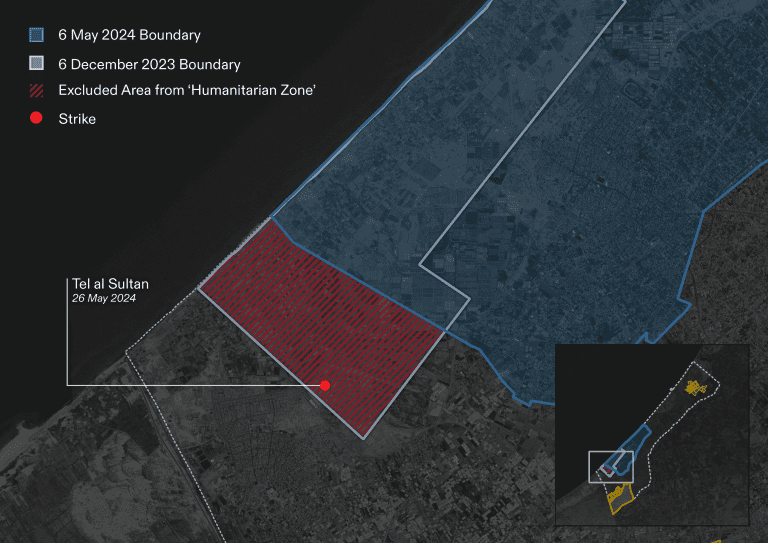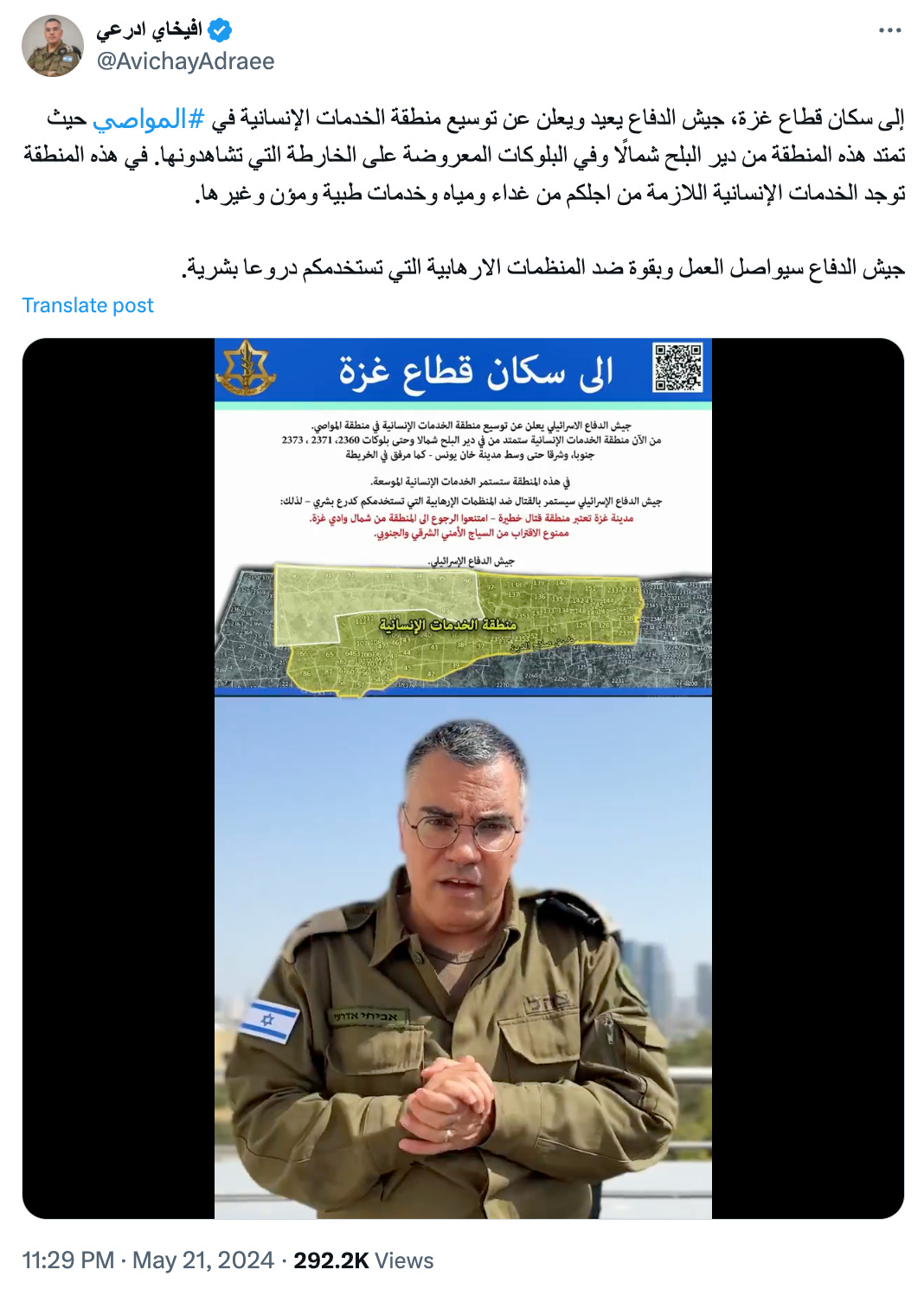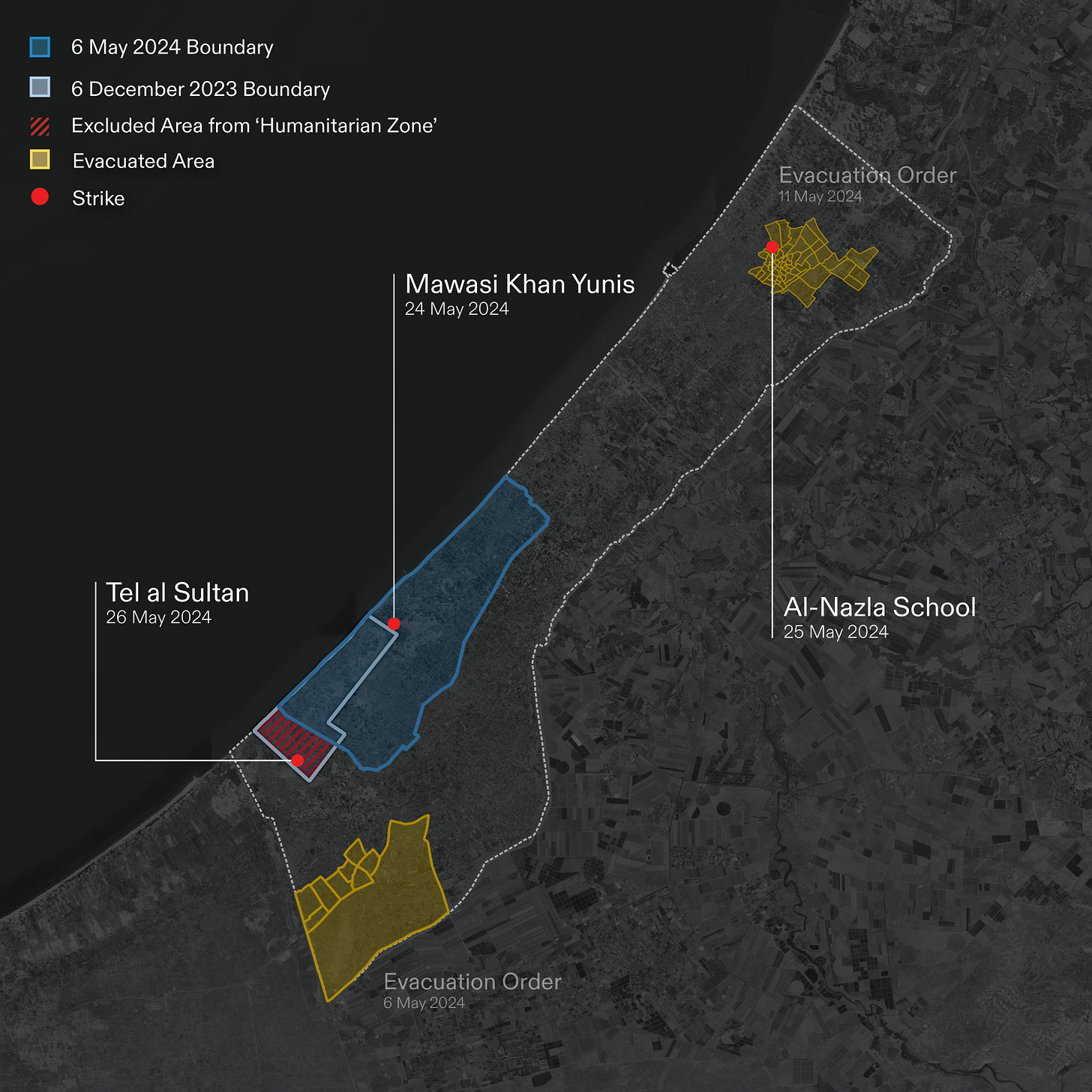Israel Declares 'Humanitarian Zones' in Gaza, Then Attacks Them
Our new study shows the Israeli airstrike on a tent camp in Tel al-Sultan was part of a series of attacks on Israeli-declared safe areas filled with Palestinian civilians.
Israel claims that the poorly worded 24 May ruling by the International Court of Justice gives it license to continue attacking Palestinians in Gaza, if it warns civilians to evacuate combat zones and move to safe 'humanitarian zones'. But we have geolocated three recent strikes within areas Israel suggested were safe.
Before Israel bombed Tel al-Sultan, it told civilians to flee there for safety.
On 26 May, Israel bombed a tent camp for displaced civilians in Tel al-Sultan, west of Rafah, killing at least 45 people, including children. The airstrike—and graphic videos that circulated on social media in the aftermath, showing dismembered, charred bodies—shocked survivors, who thought they were in an area Israel had declared safe. Outraged foreign officials expressed horror and denounced Israel’s bombing of a ‘camp inside a designated safe zone’.
In response, Israel’s military urged journalists to report that, ‘contrary to Hamas’ lies and misinformation’, the bombs were not dropped on tents inside the boundaries of the ‘Al-Mawasi Humanitarian Area’ that Israel had unilaterally declared on 6 May. That line, and an Israeli map of the ‘expanded humanitarian area’ Israel directed citizens of eastern Rafah to evacuate to on 6 May, which did not include Tel al-Sultan, featured prominently in news reports and graphics explaining where the strike had taken place.

But those news articles and graphics failed to make an important point: before 6 May, Israel’s military had published a different map of the ‘humanitarian zone’ around al-Mawasi that stretched further south and included the part of Tel al-Sultan where the tent camp was located. That map was published in infographics as part of a 6 December press release from Israel’s military, which accused Hamas of firing rockets ‘from al-Mawasi humanitarian zone’. The same Israeli press release also included an aerial photograph and precise coordinates for another alleged launch site near tents in Tel al-Sultan, just a few hundred metres from the site of the 26 May attack. That image featured a boundary for a discrete ‘humanitarian zone’, which has not been referenced or described in any other material published by the Israeli military during the current invasion of Gaza.
In a crucial way, Israel’s description that the previously defined humanitarian zone had been ‘expanded’ was misleading. While the 6 May area designated safe by Israel is larger than that included in the map published on 6 December, the ‘humanitarian zone’ has in fact been moved, without this being fully or clearly communicated to the civilians who would have relied upon that information for their safety. And importantly, the southern portion of the zone as it was defined in December was, without explanation, excluded on 6 May. That change, unacknowledged by the Israeli military, and largely unknown to the Palestinian population, meant that thousands of people sheltering in the Tel al-Sultan tent camp were no longer safe from attack, as they had been promised by Israel months earlier.
Satellite imagery shows an expansion of tents in areas within the newly excluded portion of the humanitarian area between 6 May and 26 May, underlining that the news of the boundary changes had not reached many Palestinian civilians fleeing west from Rafah ahead of the expected Israeli ground invasion.
What’s more, in the months before 6 May, Israel’s military repeatedly defined Tel al-Sultan as a ‘humanitarian zone’. When Abu Mohamed Abu Al-Sabaa, a 67-year-old survivor of the Israeli attack on the camp, spoke to the Palestinian journalist Mohamed El Saife the day after the strike, he was holding the Israeli leaflet that led him to seek safety there. The leaflet explicitly directed civilians to evacuate their homes in other parts of Gaza and go to ‘the humanitarian zone in Tel al-Sultan’ for their ‘safety’.
Our report Inhumane Zones, published on 20 May, repeated our earlier warnings that Israel has failed to publish consistent, clear information that is accessible to Palestinian civilians in any way that can credibly be called ‘humanitarian’. Another such instance occurred on 22 May, in this social media post by the Israeli army’s Arabic spokesperson.

On-screen text within the video attached to the post reads: ‘the safe zone was expanded from Deir al-Balah in the north, to blocks 2360, 2371, 2373 in the south’, following a ‘block’ system devised by the Israeli military, but not widely understood on the ground, where for many among Gaza’s civilian population, there are no means to figure out what ‘block’ they are in.
The 22 May social media post did not clarify whether these blocks were included or excluded. Indeed, the newly defined boundary appears to cut directly through those three blocks. Adding to the confusion, a bizarre decision by the Israeli military’s video graphics team made the information contained in the video significantly harder to reliably understand: while the video slowly expands the newly defined highlighted area, the remainder of the map retains its size, which makes it look like additional parts of southern Gaza have now been included in the safe area.
The Israeli military’s communication of ‘safe’ or ‘humanitarian’ zones in this way—relying on low-resolution maps and confusing motion graphics—is demonstrably ineffective and leaves civilians in harm’s way. This lack of clarity is part of a pattern since October 2023 of unclear, inconsistent, and contradictory information published by the Israeli military regarding so-called ‘safe zones’ and ‘evacuation orders’.
Attacks in grey zones and in the ‘expanded humanitarian zone’
We have also identified additional recent examples of attacks outside of designated ‘evacuation areas’, which have resulted in civilian loss of life, and of Israeli airstrikes occurring within the 6 May boundaries of the al-Mawasi humanitarian zone.
A day before the Tel al-Sultan bombing, on 25 May, in Jabalia, the Israeli army attacked al-Nazla school where displaced people had taken refuge. Ten civilians were reportedly killed.

The school is located in Block 975, according to the Israeli evacuation grid system. On 11 May, the Israeli army had issued an evacuation order to large parts of Jabalia in north Gaza. However, Block 975 was outside the area ordered to evacuate.
A reporter for Al-Araby noted that the school was considered by those sheltering there to be in a ‘safe area’, since it was excluded from the zone ordered to evacuate.
According to the Al-Araby report, the school did not receive any warning calls or leaflets ordering evacuation before the strike, which killed five women and five children, the oldest of whom was 14.
Critically, our analysis of recent video evidence indicates that Israel is also conducting airstrikes in areas that are clearly within the most recently defined boundaries of the ‘expanded humanitarian area’, announced on 6 May. This video from 24 May clearly shows an Israeli missile landing well inside the boundaries of the area Israel has most recently encouraged civilians to shelter within.

We geolocated this airstrike west of Asdaa City in Khan Younis. The crater left by this attack is visible in a satellite image from 25 May 2024.

While the international outrage that followed the attack on Tel al-Sultan is well-justified, efforts to report upon that attack have evidenced a further outrage: Israel’s presentation and publication of its ‘humanitarian’ measures is inconsistent, poorly communicated, and demonstrably failing to protect civilian lives.
In a context in which as many as 1.5 million Palestinian civilians are seeking safe refuge from Israeli’s continued ground and air assault, such a limited, incomprehensible, and often inaccessible set of instructions (civilians in Gaza are faced with significantly limited internet connectivity, and regular blackouts), Israel’s efforts can only be understood as performative, aimed at rebutting criticism from international observers instead of protecting Palestinians civilians. The orders themselves evidence little regard for the safety of those civilians, rather inspiring uncertainty and fear, notwithstanding multiple well-evidenced examples wherein those orders have led directly to civilian deaths.
For more details on how Israel has weaponized the notion of humanitarian measures to give its armed forces free rein in Gaza, read our two recent reports:




